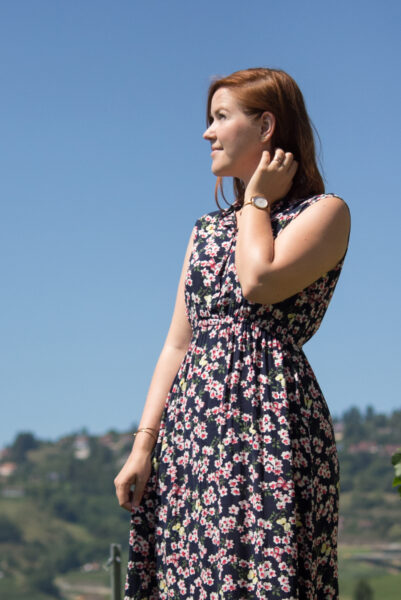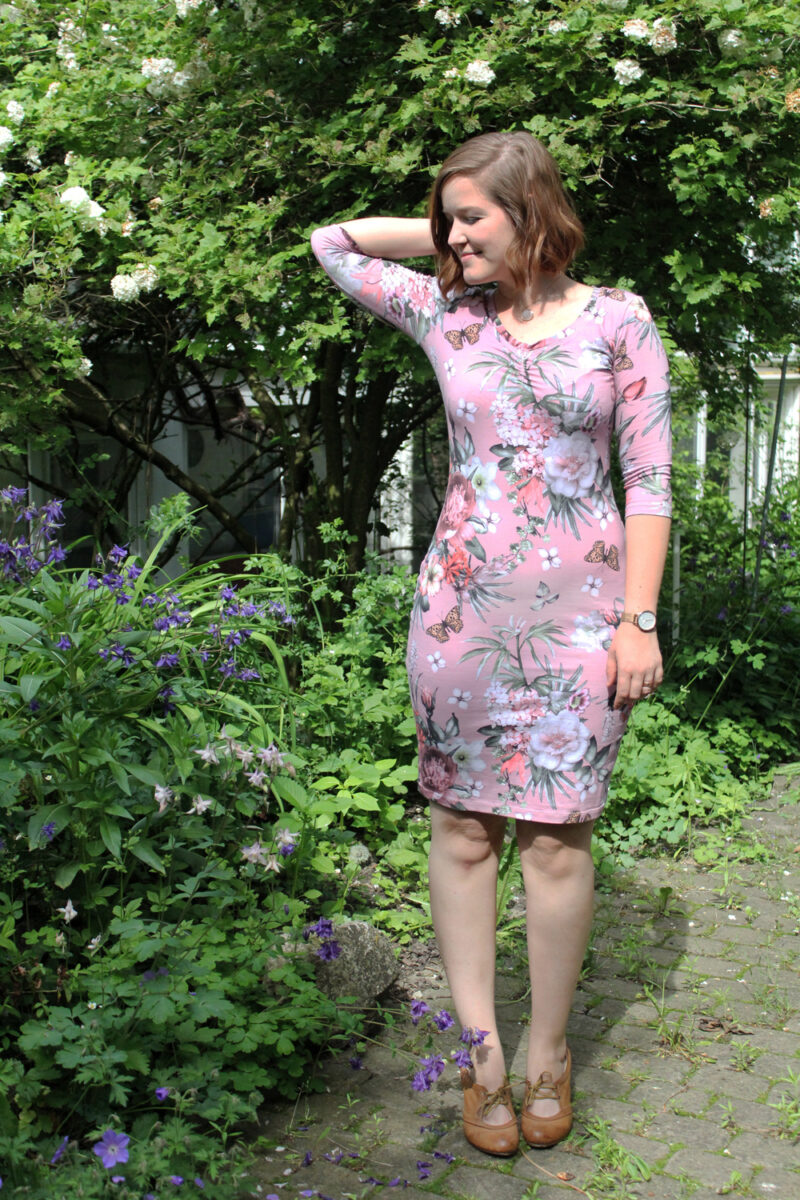The Fabric Shopping Trap // Why buying less fabric is good for your mind (and the environment)

When I’m not sitting behind the sewing machine, I work full-time as a psychologist. This is why I every once in a while share a mental health-related post on this blog. Please grab a coffee and join the conversation!
***
Which one of you considers themselves a hoarder? An addict?
Add the word fabric and I’m all in.
I’m definitely guilty of having a slightly unhealthy relationship with buying fabrics. I have all the cute postcards, signs and coffee mugs about how fun my fabric shopping addiction is.
Fabric shopping is amazing: I get home from a long and exhausting day at work. I could sew now to feel relaxed, empowered, fulfilled and productive and just generally good about myself. Instead I decide to flop on the couch with a glass of wine, get inspired by Instagram makers, feel bad about neglecting my hobby and then decide to check out some cute fabric online shops for a little inspiration. Browsing through endless creative possibilities I finally feel connected to my favourite pastime again, I get the happy sewing feels, I get a rush and decide to spend just a little more than I planned to spend after I decided to skip not spending anything altogether. Seeing the order hitting my inbox makes me happy. I will sew again, very soon, I promise.



Fabric shopping – It’s a trap!
Our brain makes us feel happy when we shop. When we buy ourselves things our brain’s reward centre jumps into action and releases neurotransmitters like dopamine, that makes us feel good about what we just did and makes it more likely that we’ll do it again. Like when eating chocolate, or having sex. (Or taking drugs.)
Dopamine isn’t just released when we get a reward, but it’s also actually released in anticipation of a reward. Thus enters the joy of online shopping. It’s TWICE THE FUN! A couple of clicks and we get ourselves a double dopamine hit! First, when we order and second, when our order finally arrives in the mail. So in a way, online shopping isn’t only easily accessible it’s more exciting for our brain than shopping in person.
Finishing a project or buying fabric both triggers a dopamine response reward.
This is the reason why fabric shopping feels just as fun as sewing itself. It’s a pretty good substitute in the short term. But that’s about it. It’s a trick of the mind, and induces the feeling that we’re doing something for our hobbies, when we’re actually just lying on the couch stressed-out and scrolling through online shops. It gives us pleasure, we feel connected to our hobby without actually engaging in it. So it feels like a pretty good alternative when we can’t muster the energy to get immersed in a project.
Shopping for our hobby can feel like a pretty smart shortcut to calming our conscience, upping our mojo, feeling creative and engaged
Problem is, this only lasts for a pretty short time. Long-term – that’s not hard to guess – it doesn’t get us any of the benefits we achieve when we sew, make, create stuff. (Read more about the benefits of sewing here.) In our fast-paced lives we sometimes struggle to find the time and motivation to immerse ourselves in a slow-paced, mindful activity like sewing, embroidery or knitting. So shopping for our hobby can feel like a pretty smart shortcut to calming our conscience, upping our mojo, feeling creative and engaged.
I love fabric shopping. And I’m not saying that fabric shopping is a bad thing. But gaining pleasure from unnessecary and unsustainable fabric shopping instead of getting into action and sewing with the fabrics we already bought last time kind of defeats the purpose of sewing as a mindful and sustainable activity.






‘Lifetime’ stash – pleasure or pressure?
Just to be clear, I’m not talking about having a stash of five different fabrics at home. I’m talking so-called “lifetime stashes”, stashes so huge, we will never have the time to use them up while buying more fabrics in the meantime. I’m a fabric hoarder myself, let’s get this out. I buy fabrics because I like them, not because I need them urgently for a particular project. Lifetime stashes are fun. We pride ourselves with them on social media. I tell myself I’ll never have to leave the house or wait for an online order, because I always have everything I need for any project right at home with me. Does this keep me from adding to the stash? Hell, no! The sad thing is: I started to feel pressured by it. It’s not a trophy, more like a silent reproach. It’s a constant reminder of all the things I haven’t made yet.
Fabrics are not environmentally “neutral”. Polyester fabrics are one of the major sources of oceanic pollution and microplastics in our waters.
Furthermore, I turn my sustainable hobby into a hoarding business. I bought more than I will ever use (if I don’t stop buying). Fabrics are made from natural, animal or artificial fibres. They’re not environmentally “neutral”. Demand determines supply. The more fabrics we buy, the more fabrics are produced, using cottons, wool, all sorts of fibres and – sorry to break it to us – non-recyclable materials and a lot of microplastics. Polyester fabrics especially are one of the major sources of oceanic pollution and microplastics in our waters. But even natural fibres – cotton, linen, wool – are made by cutting down plants, animal farming and exploiting poorly paid workers in developmental countries.
I always took pride in the fact that I am independent from having to shop for my own clothes, that I support slow fashion and sustainability. Instead, I have been fooled by my own laziness and my brain’s reward centre into hoarding materials.

Realising this, I have done two things:
First, I stopped buying fabrics. I actually haven’t bought any fabrics in almost a year now. More than a year, if I do not count the fabrics I bought as mandatory souvenirs on my last holidays – but I do. Instead, I’ve only used fabrics from my stash to sew and have been able reduce the amount of fabric in my sewing corner to some extent (probably only visible to my eyes if you ask the Mister). It feels really freeing to destash and I got inspired by the limits I set myself to up my creativity game. More often than not I feel happy going through my stash before the next project instead of feeling guilty. I try to be more conscious about fabric choices and and my own impact on the fabric industry.
Second, not being able to online shop instead of sewing, I finally had to tackle my inner conflict when I was just too lazy or tired or exhausted to sew and felt bad about it. That was interesting! Why do I feel guilty about not engaging in a self-imposed activity that is meant to promote relaxation and general well-being? I had to learn to tell myself that it’s ok to take a break from a thing I love every now and then. It doesn’t mean that I’ve stopped loving sewing and need to get stressed about it. It just means that I do not feel like sewing and not need to get stressed about it.
Since I stopped substituting sewing with fabric shopping, I haven’t actually sewn that much more. I read a lot. I knit. I took up spinning wool (it’s amazing!). It’s been a lot of fun!
The other day I wanted to make a dress and didn’t have the right kind and amount of fabric I needed at home… I made something else instead.

Allowing myself to do what makes me happy and to take a break from it when it doesn’t make me happy reduced some of the time I spend sewing or taking pictures of finished projects. Instead, I’ve been really enjoying blogging some other content, posts like this one and articles about mental health.
Are you enjoying reading these? What’s your relationship with fabric shopping like? I’d love to hear from you and get some feedback!
xx
Charlie
Happy sewing!
♥
facebook/bloglovin/pinterest
twitter/instagram
Stay in touch!
























































